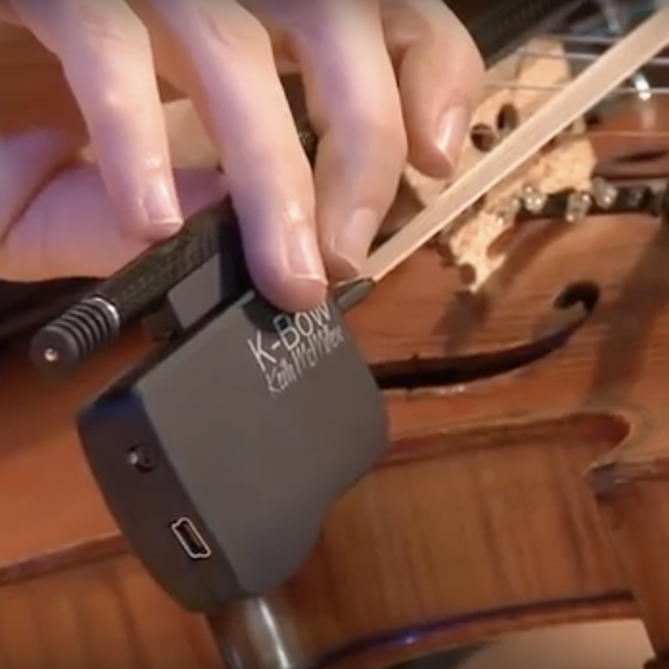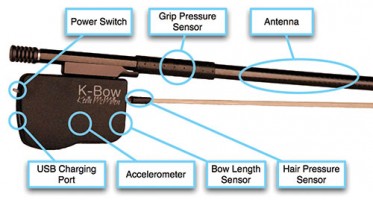
K-Bow (Part 1)
Jeffrey Zeigler
 A few weeks ago my quartet traveled to Syracuse University for a week long residency. While there we had many interesting and thought provoking interactions with the student body. Our activities ranged from giving a standard string master class to a screening and discussion about the film Requiem for a Dream to a discussion about how one could navigate their way through the music industry. We also worked with a team of film students for a music television show called Loud and Clear. But perhaps the most distinctive activity of the week involved our concert that utilized a new and extremely innovative technology. The new device that we used is called the K-Bow.
A few weeks ago my quartet traveled to Syracuse University for a week long residency. While there we had many interesting and thought provoking interactions with the student body. Our activities ranged from giving a standard string master class to a screening and discussion about the film Requiem for a Dream to a discussion about how one could navigate their way through the music industry. We also worked with a team of film students for a music television show called Loud and Clear. But perhaps the most distinctive activity of the week involved our concert that utilized a new and extremely innovative technology. The new device that we used is called the K-Bow.
Before we continue I need to answer the question: what is the K-Bow? In the simplest terms, the K-Bow is a composite carbon fiber and kevlar sensor bow that can be used both as an electronic trigger and an effects processor. It comes in two parts—the actual bow which sends all of the movement and gestural information and the software K-Apps which allows you to map these gestures onto musical or video processes. You can use it to trigger audio files. You can use it to manipulate the sounds that you make from your live performance. It has a built in looper. You can use it to sound like an electric guitar or use it as a pitch shifter. You can use it to interact with video, lights and surround sound speakers. Basically, this bow can do almost anything except make an espresso.
The bow is made by Keith McMillen Instruments (www.keithmcmillen.com). The bow’s visionary creator, Keith McMillen initially made his name in the field of electronic string instruments when, in 1979, he founded Zeta Instruments. These instruments revolutionized electronic string playing.
The K-Bow is not the only product made by KMI. they also make a foot pedal called the SoftStep foot controller, a chromatic keyboard foot controller called the Twelve Step, the String Port which is a device used to expand one’s sonic palate through MIDI and a battery charge measuring device the Batt-O-Meter.
So here is how the K-Bow works:
To get started you will need an Intel Mac OS 10.5.6 or later that can communicate via Bluetooth, has at least 30 MB free hard disk space and has a working audio interface to channel your instrument’s audio. You will also need an instrument with a mic or pickup to provide audio to your computer.
On the K-Bow itself, there is a grip sensor located inside the grip near the frog. There are also two sensors inside the stick of the bow. Within the frog there is an X-Y-Z accelerometer that measures the speed of movement and a bow length sensor. There is also a sensor that measures the pressure of the hair. With all of this gadgetry you may be wondering how much the bow weighs. It weighs within the same range as any other bow you will play on. In fact, mine is a little lighter than the wooden bow I play on.
Along with the bow, one also needs to attach something called the Emitter below their fingerboard. Don’t worry. This will not damage anything and will not even leave a mark on your fingerboard.
The Emitter transmits infrared and radio signals to the bow in order to read its proximity and position. This information is sent to the computer via Bluetooth.
There are two software programs that one needs to download in order to use the K-Bow. They are called K-Data and K-Apps. K-Data is used to make the connection with the bow which is made via Bluetooth. It is within this software that the computer is able to track the speed and positioning of the bow.
The other program is called K-Apps. This is the program that deals with all of the effects processing, looping and audio and video playback.
Here is a link to a video of the extraordinarily brilliant Jon Rose demonstrating the use the K-Bow.
http://www.youtube.com/watch?v=0bddNDOQuyU
No question this bow will revolutionize electronic string performance. In future blog posts I will discuss the work that my quartet has done with this bow and more about our residency at Syracuse University.
Subjects: Technology
Tags: cello, cellobello, device, discussion, interactions, Jeffrey, k-bow, Kronos, Master Class, music, Quartet, Zeigler
